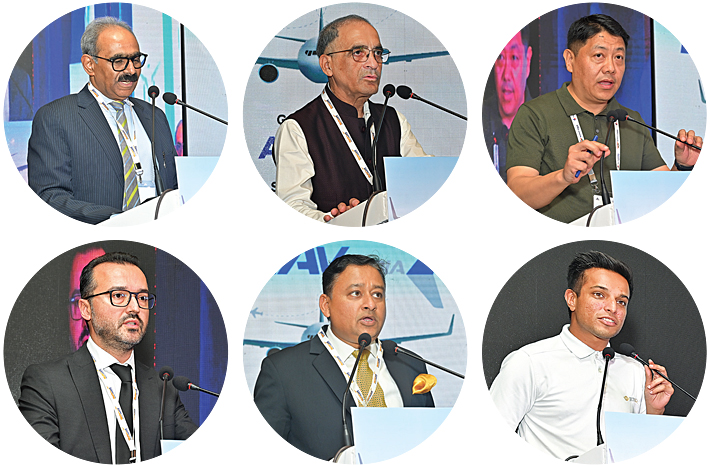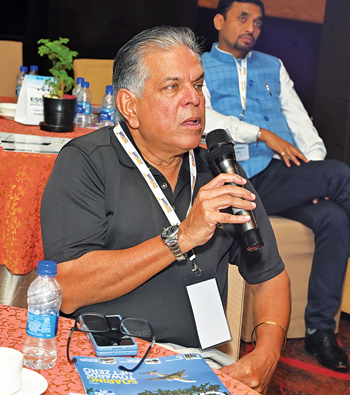- Home
- In This Issue
- Story
|
|||
Unlocking the Potential
Steps towards informed decision-making and proactive engagement are essential for overcoming the hurdles and fostering a more efficient and competitive Business Aviation environment in India

On January 17, 2024, on the sidelines of Wings India 2024, Hyderabad played host to the eighth edition of the BizAvIndia conference. This gathering marked the evolution of the Business Aircraft Operators Association (BAOA), signaling its growing influence and organisational prowess, alongwith the growth of the industry.
As India’s economy continues its upward trajectory, increasing attention is being sought to be directed towards the General Aviation (GA)/Business Aviation (BA) sectors for their indispensable contributions to the nation’s development. Recognising this, the conference set out to address the myriad challenges facing the GA/BA industry in India while critically evaluating potential solutions. From discussions on safety and taxation to exploring avenues for fractional ownership and fostering the growth of GA/BA Maintenance, Repair, and Overhaul (MRO) facilities, the conference provided a comprehensive platform for industry experts, stakeholders, regulators, and government representatives to exchange ideas and insights. With a focus on fostering sustainable long-term growth, the event delved into new plans and innovative technologies aimed at enhancing the efficiency and expansion of the GA/BA industry in India.

“I express our gratitude for the increased attention the government is giving to the GA/BA industry, recognising its essential role in the last mile connectivity and its contribution to the nation’s economic growth. As the BAOA, we remain committed to playing a constructive and progressive role in ensuring the safe, efficient and optimal growth of the GA/BA industry in our country. The role of GA/BA has become even more crucial for our fast growing economy,” said Harsh Vardhan Sharma, President BAOA. He added that at present, the GA/BA is driven by corporate charters, conventional and pilgrimage tourism and further highlighted the six crucial contributions it can further make.
JOINT SECRETARY, MINISTRY OF CIVIL AVIATION, ASANGBA CHUBA AO SAID, “WHILE THE COMMERCIAL AVIATION SECTOR CONTINUES TO SOAR, EFFORTS ARE UNDERWAY TO ENSURE THAT THE BENEFITS EXTEND TO ALL SEGMENTS.”
- Empowering Large Corporates: Business Aviation provides essential power and mobility to large corporates, giving them a competitive edge in today’s global economy. However, there’s a pressing need to modernise the current fleet with more advanced aircraft to maintain this edge.
- Last Mile Connectivity in Himalayan States: Many Himalayan states are still lacking crucial last-mile connectivity. While the Ministry of Civil Aviation (MoCA) is working to address this issue, progress has been slow. Existing Non-Scheduled Operator (NSOP) operators in these regions are best positioned to meet the demand for improved connectivity.
- Emergency Medical Services: Business aviation can significantly contribute to providing emergency medical services, not only in difficult terrain but also in plains areas where access is limited.
- Support for Aerial Work: Suitable aircraft are needed for various aerial work tasks such as construction of roadways, power lines, and mapping. Due to the lack of suitable aircraft, foreign registered aircraft are temporarily imported under NSOP permits to carry out such projects.
- Support for Defence and Paramilitary Forces: Defence establishments and paramilitary forces regularly require helicopters to transport personnel, machinery, and goods. However, NSOP operations have struggled to meet these demands due to a lack of available aircraft.
- Disaster Relief Support: State governments often require helicopters for disaster relief operations to reach affected areas, saving lives, and providing relief material to those stranded. Business aviation can play a vital role in facilitating these relief efforts.

Adding regulator’s perspective, Manish Kumar, Joint Director General of the Directorate General of Civil Aviation (DGCA), highlighted India’s aviation sector’s rapid growth, projecting it to become the third-largest passenger market by 2024. Emphasising safety as paramount, Kumar outlined DGCA’s focus on safety in all aviation operations, supported by circular guidance materials and rigorous assessment processes for operational approvals. He addressed safety concerns in hill operations, emphasising the importance of skill and decision-making, with new training processes implemented. Kumar also noted safety challenges like runway incursions and loss of control, suggesting measures such as establishing committees for data collection at unlicensed airports and improving pilot preparation. He urged investment in competent safety managers to mitigate operational risks effectively, concluding with the critical importance of prioritising safety in aviation operations.
The helicopters sector under GA/BA has also been awaiting its due take-off in India ad holds immense scope and opportunities. Sunny Guglani, Head of Airbus Helicopters, Airbus India and South Asia & Chairman, FICCI Taskforce on Helicopter and General Aviation touched upon the helicopter industry. “As the South Asia Chairman of the FICCI Taskforce on Helicopter and General Aviation, I’m pleased to report significant progress in India’s aviation industry. Despite challenges from the COVID-19 pandemic, both commercial and general aviation, including helicopters, are experiencing remarkable growth. MoCA’s proactive initiatives have had a positive impact, particularly for helicopters. Airbus Helicopters has achieved significant milestones this year, including the selection of the H145 for offshore operations and the impending introduction of the H160 into the Indian market. Our ambition is to make helicopters more accessible to the masses, aligning with the vision of democratising air travel. Initiatives like Project Sajeevani aim to make helicopter services more accessible and affordable for medical emergencies,” he said. There’s also a growing need to utilise helicopters for law enforcement purposes to enhance public safety. Sustainability is a key focus area, with efforts underway to ensure helicopters can operate on sustainable aviation fuel by the end of the decade. Overall, prioritising accessibility, safety, and sustainability will enable the aviation industry to contribute to the growth and development of our nation.
“I EXPRESS OUR GRATITUDE FOR THE INCREASED ATTENTION THE GOVERNMENT IS GIVING TO THE GA/BA INDUSTRY, RECOGNISING ITS ESSENTIAL ROLE IN THE LAST MILE CONNECTIVITY AND ITS CONTRIBUTION TO THE NATION’S ECONOMIC GROWTH,” SAID HARSH VARDHAN SHARMA, PRESIDENT BAOA
Government’s perspective was shared at the conference through Chief Guest, Joint Secretary, Ministry of Civil Aviation, Asangba Chuba Ao who remarked that in the dynamic landscape of India’s aviation industry, we are witnessing promising days ahead, fueled by our nation’s status as one of the fastest-growing aviation markets worldwide. From small aircraft to major players, the aviation domain encompasses a vast spectrum of operations. “I want to underscore the unwavering support of the MoCA for the GA/BA segment. While past support might have been lacking, the current trend indicates a positive trajectory, with a clear commitment to addressing industry needs. The Ministry’s proactive engagement with stakeholders in recent years reflects a concerted effort to find solutions to even the most complex challenges. Every issue, no matter how daunting, is open for discussion and resolution,” he said. He further assured that safety remains paramount, and efforts are underway to bolster the regulatory framework and workforce capacity to address the growing demands of the civil aviation sector. Despite constraints, significant strides have been made, with numerous appointments sanctioned to strengthen oversight in the GA/BA sector.
The UDAN scheme stands as a testament to the government’s commitment to fostering diversity and accessibility in aviation. This initiative has facilitated the introduction of various aircraft types into the Indian skies, catering to diverse needs across the country. Looking ahead, he acknowledged there are vast untapped opportunities in segments like helicopters and seaplanes, which have the potential to revolutionise transportation in India. By expanding infrastructure and streamlining regulations, we can create an environment conducive to the growth of smaller aircraft operations.

“India’s vast population presents immense opportunities for aviation growth, particularly in remote and underserved regions. While the commercial aviation sector continues to soar, efforts are underway to ensure that the benefits extend to all segments of the population. I urge stakeholders to seize the opportunities on the horizon and work collaboratively towards the advancement of India’s aviation sector. Wings India serves as a platform to unite voices and foster business collaborations that will propel the industry forward,” the Secretary concluded.
Sudhir Rajashirke, CEO JetClub, talked about making the best of the opportunities, stating that over the next decade, our main focus will be on analysing and developing the fixed-wing aircraft market, while recognising the significant growth potential of helicopters as a distinct segment. It’s important to manage expectations regarding market penetration timelines, learning from past mistakes and adopting a strategic approach tailored to India’s unique dynamics. Preparation efforts are underway within companies to align product offerings and operational frameworks with market requirements, emphasising the need for meticulous planning and understanding of customer preferences. Clear communication, transparent pricing, and robust backend systems are essential for success, along with addressing taxation and legal considerations to ensure compliance and operational efficiency. By prioritising careful planning, communication, and adherence to regulatory standards, we can capitalise on opportunities and drive sustainable growth in the Indian business aviation industry.
COL. SANJAY JULKA - CEO - TECHNICAL, AR AIRWAYS UNDERLINED THE IMBALANCE BETWEEN DEMAND AND SUPPLY, WHICH IS EVIDENT, PRIMARILY DUE TO INADEQUATE INFRASTRUCTURE AND EXPERIENCE IN THE MRO INDUSTRY
Col Sanjay Julka - CEO - Technical, AR Airways threw the spotlight on the MRO situation in India. “As per the Director of McKenzie, India’s prominence in aviation is not just limited to this decade but extends to the entire century. With the third-largest passenger traffic globally, there’s a growing demand for MRO services from defence services. Despite invitations from defense officials to maintain their aircraft, the MRO sector faces challenges due to a disruption in demand. The imbalance between demand and supply is evident, primarily due to inadequate infrastructure and experience in the MRO industry. Only 1 per cent of the global MRO business is conducted in India, highlighting the need for improvement in infrastructure and regulatory frameworks. To address this:
- We need to enhance infrastructure through government schemes like Mudra and GIFT and align regulations with global standards.
- Additionally, encouraging OEMs to establish their presence in India can boost the MRO sector by training local manpower.
- Establishing a task force under MoCA and conducting microlevel studies are essential steps to drive industry growth.
- Collaborative efforts between industry associations and proactive measures are crucial to propel the MRO industry forward in India.
In the business aviation industry in India, several procedural challenges hinder the smooth execution of aircraft transactions. Aman Kapur, Sales Director, JetHQ, brought some of these key issues into focus. “Private category entities face delays in DGFT NOC approval due to infrequent meetings. Indian buyers encounter extended wait times for security clearances and banking approvals, putting them at a disadvantage compared to international buyers. RBI guidelines allow fund transfers, but using Escrow can cause delays as banks view it as a third party. Import restrictions on aircraft older than 18 years and complex processes for ferrying aircraft to India add further challenges. Recent DGCA guidelines also mandate additional documentation, complicating the registration process. Addressing these challenges is vital for a more efficient and competitive business aviation environment in India,” he highlighted.
The deliberations converged that it is imperative for stakeholders within the business aviation industry in India to collaborate effectively with government bodies such as the Ministry and the DGCA to address the procedural challenges outlined. Informed decisionmaking and proactive engagement are essential for overcoming these hurdles and fostering a more efficient and competitive business aviation environment. By working together, industry professionals can contribute to the growth and development of business aviation in India, ensuring its continued success in the years to come.
Contacts
BizAvIndia, A quarterly magazine which will focus on the challenges and opportunities of business aviation, a segment which has tremendous potential to grow. It's a supplement of SP's Aviation, the flagship aviation magazine from SP Guide Publications.
SP Guide Publications Pvt Ltd, A-133, Arjun Nagar, Opposite Defence Colony, New Delhi 110 003, India.Phones : +91 - 11 - 40042498, 40793308.
All Rights Reserved
Managed By SP Guide Publications





